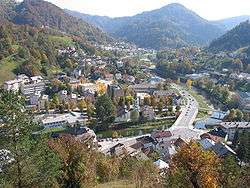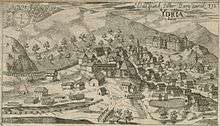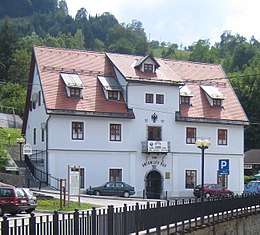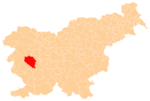Idrija
Idrija (pronounced [ˈiːdɾija] (![]()
Idrija | |
|---|---|
 | |
 Idrija Location in Slovenia | |
| Coordinates: 46°00′4.74″N 14°01′19.59″E | |
| Country | |
| Traditional region | Inner Carniola |
| Statistical region | Gorizia |
| Municipality | Idrija |
| Area | |
| • Total | 13.1 km2 (5.1 sq mi) |
| Elevation | 334.5 m (1,097.4 ft) |
| Population (2002) | |
| • Total | 5,878 |
| Climate | Cfb |
| [1] | |
| Official name | Heritage of Mercury. Almadén and Idrija |
| Type | Cultural |
| Criteria | ii, iv |
| Designated | 2012 (36th session) |
| Reference no. | 1313 |
| State Party | Spain |
| Region | Europe and North America |
Geography
The town of Idrija lies in the Idrija Basin, surrounded by the Idrija Hills. It is traversed by the Idrijca River, which is joined there by Nikova Creek. It includes the hamlets of Brusovše, Cegovnica, Prenjuta, and Žabja Vas close to the town center, as well as the more outlying hamlets of Češnjice, Ljubevč, Kovačev Rovt, Marof, Mokraška Vas, Podroteja, Razpotje, Staje, and Zahoda. The Marof hydroelectric plant is located on the Idrijca River on the northern outskirts of Idrija, between Marof and Mokraška Vas. Springs in the area include Podroteja Spring[5] and Wild Lake on the Idrijca River south of the town.
History


Mercury was discovered in Idrija (known as Idria under Austrian rule) in the late 15th century (various sources cite 1490,[6][7][8] 1492,[9][10] and 1497[6][8]). Mining operations were taken over by the government in 1580. The mineral idrialite, discovered here in 1832, is named after the town.
Legend
According to legend, a bucket maker working in a local spring spotted a small amount of liquid mercury over 500 years ago. Idrija is one of the few places in the world where mercury occurs in both its elemental liquid state and as cinnabar (mercury sulfide) ore. The subterranean shaft mine entrance known as Anthony's Shaft (Antonijev rov) is used today for tours of the upper levels, complete with life-sized depictions of workers over the ages. The lower levels, which extend to almost 400 meters below the surface and are no longer being actively mined, are currently being cleaned up.
Church
The parish church in the town is dedicated to Saint Joseph the Worker and belongs to the Diocese of Koper. There are three other churches in Idrija, dedicated to the Holy Trinity, Saint Anthony of Padua, and Our Lady of Sorrows.[11]
Notable people
Notable people that were born or lived in Idrija include:
- Aleš Bebler (1907–1981), Slovene Communist leader, resistance fighter, and diplomat
- Jožef Blasnik (1800–1872), printer, publisher
- Stanko Bloudek (1890–1959), designer
- Borut Božič (born 1980), professional road cyclist
- Aleš Čar (born 1971), writer
- Karel Dežman (1821–1889), Carniolan politician and scholar
- Damir Feigel (1879–1959), writer, journalist, cultural worker, satirist, humorist, father of Slovenian science fiction, national awakener and anti-fascism fighter
- Heinrich Freyer (1802–1866), Slovenian botanist, cartographer, pharmacist and natural scientist
- Ludvik Grilc (1851–1910), painter/portrait painter
- Belsazar Hacquet (1739/40–1815), French natural scientist
- Marko Hatlak (born 1980), accordionist
- Vladimír Karfík (1901–1996), Czechoslovak architect
- Eva Lucija Cecilija Viktorija Emilija Kraus, (1785–?), Baroness of Wolsberg, lover of French Emperor Napoleon
- Marko V. Lipold (1816–1883), Miner, geologist and lawyer, known as the father of Slovenian geology
- Jožef Mrak (1709–1786), one of the most notable Slovenian polytechnicians
- Pier Paolo Pasolini (1922–1975), Italian film director and poet
- Vasja Pirc (1907–1980), chess grandmaster
- Nikolaj Pirnat (1903–1948), sculptor, painter, illustrator and author
- Zorko Prelovec (1887–1939), musician, composer, choir composition author
- Luka Rupnik (born 1993), Slovenian basketball player
- Marko Ivan Rupnik (born 1954), artist, philosopher and theologian
- Giovanni Antonio Scopoli (1723–1788), Italian natural scientist
- Jan Tratnik (born 1990), professional road cyclist
- Anton Alojzij Wolf (1782–1859), Roman Catholic bishop, philanthropist, patron of literature
- Tanja Žakelj (born 1988), Slovenian professional world champion mountain biker
See also
- The ghost town of New Idria, California, a site of mercury mining during the 19th-century California Gold Rush, was named after Idrija.
References
- Statistical Office of the Republic of Slovenia
- Leksikon občin kraljestev in dežel zastopanih v državnem zboru, vol. 6: Kranjsko. Vienna: C. Kr. Dvorna in Državna Tiskarna. 1906. pp. 124–125.
- Spezialkarte der Österreichisch-ungarischen Monarchie 1:75.000 Bischoflack und Oberidria (Map). Vienna: Militärgeographisches Institut. 1880. Retrieved January 7, 2019.
- Heritage of Mercury. Almadén and Idrija - UNESCO World Heritage Centre
- "Podroteja I – Idrijca". Hidrološki podatki. Agencija Republike Slovenije za okolje. Retrieved June 12, 2019.
- Arko, Mihael. 1931. Zgodovina Idrije: po raznih arhivalnih in drugih virih. Ljubljana: Katoliška knjigarna, p. 1.
- Savnik, Roman, ed. 1968. Krajevni leksikon Slovenije, vol. 1. Ljubljana: Državna založba Slovenije, p. 70.
- Kmecl, Matjaž. 1981. Treasures of Slovenia. Ljubljana: Cankarjeva založba, p. 262.
- Budkovič, Tomaž, Robert Šajn, & Mateja Gosar. 2003. "Vpliv delujočih in opuščenih rudnikov kovin in topilniških obratov na okolje v Sloveniji ." Geologija 46(1): 135–140, p. 136.
- Svetličič, Marjan, & Matija Rojec. 2000. "Kolektor." In Saul Estrin et al. (eds.), Foreign Direct Investment in Central Eastern Europe, pp. 3–28. New York: M. E. Sharpe, p. 3.
- Koper Diocese list of churches Archived 2009-03-06 at the Wayback Machine
Sources
External links
| Wikimedia Commons has media related to Idrija. |
- Idrija, official page of the municipality (in Slovene)
- Idrija on Geopedia
- Idrija municipal museum
- Local newspaper
- Tourist info
- Tourist information, a page in English about the town and its history
- Town portal
